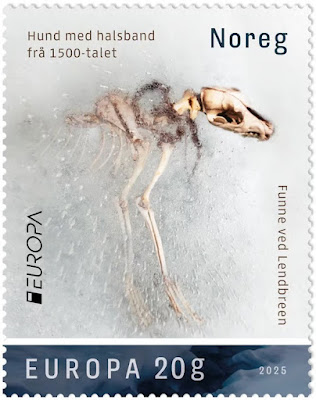 Slovakia
Slovakia
Date of Issue: 30th April 2025
one stamp (2.40 EUR)
this stamp is issued in a mini-sheet of 8 stamps
this stamp is also issued in a booklet (6 stamps) - NOTE the stamps from the booklet are self-adhesive
In the Late La Tène Age, in the 1st century BC, the acropolis of
the Celtic oppidum was located on Bratislava Castle hill. Between 2008
and 2014, archaeological research brought the discovery of rare
Celtic-Roman architecture built for Celtic nobility. A pavement of a
late-Republican type, a so-called opus signinum with a floral carpet
motif, was discovered directly beneath the courtyard of the palace.
Similar types of pavements from this period have only previously been
found around the Mediterranean. A total of seven Celtic-Roman buildings
were found on the northern terrace of the Castle and under the
18th-century Winter Riding Hall. Today, three of these buildings and the
opus signinum pavement are preserved and presented in situ.
Roman Building I which, by a miracle, escaped construction
activity that took place in the Castle in the 15th century, is located
under the Winter Riding Hall. In 2009, a precious find was made: 22
Celtic gold staters and silver coins with the inscriptions Biatec and
Nonnos were found on the pavement of the building. For the first time, a
golden coin with the inscription NONNOS was found. The treasure had
been lying in a glass Hellenistic jar the shards of which laid among the
coins. Near the coins, there was also a Roman bronze sealing box of the
Alesia type which was used to secure transport of writing documents.
These original finds may be seen in the exhibition: Celts from
Bratislava, at Bratislava Castle and copies can be seen in “The BIATEC:
Celtic Mint exhibition” at the Bratislava City Gallery at 19 Panská
Street.
The best preserved of the seven buildings is Roman Building II,
probably the house of a merchant of rare goods. In addition to Celtic
pottery and small metal decorative objects, imported goods were also
found here: Roman wine and oil amphorae, a 12kg brass ingot, a bronze
bell, glass, gold foils, Baltic amber, coins and many others. Wine and
olive oil were imported in amphorae directly from Italy and the
Mediterranean. By the western bastion of the Castle, a massive
rectangular building, Roman Building VII was discovered, with 17m-long
walls and two massive pillars. It might have been used as a warehouse
for precious goods. Its preserved remains can be seen in the foyer in
front of the Winter Riding Hall.
These finding tell us that the Celtic social elite was Romanised as
early as the 1st century BC. It puts the territory of Bratislava and its
wide hinterland at the centre of interest of the Roman Empire in the
period when the Limes Romanus borders on the Danube did not yet exist.
Finds of gold and silver coins, wine amphorae, amber and other objects
testify to the luxurious lifestyle on the Celtic Acropolis. The stone
architecture discovered at Bratislava Castle was built by Roman
builders, probably between 50 to 40 and 30 to 20 BC. They did not exist
for very long. The final destruction of the Celtic oppidum might have
been a consequence of the invasion of Germans from the north, sometime
around the turn of the century.
Margaréta Musilová
 Malta
Malta



















































